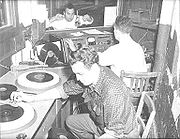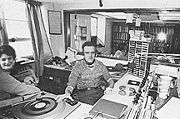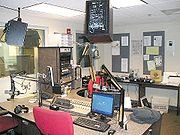
WHUS
Encyclopedia
WHUS is the commercial
-free college radio station of the University of Connecticut
. It is one of the oldest radio
stations in Connecticut
, with roots going back to just after World War I
. It is a community radio
station, featuring members of the student body and the local community around Storrs, Connecticut
.
The community radio format allows WHUS to operate 24 hours a day, 365 days a year, at 91.7MHz on the FM
dial. WHUS broadcasts a diverse mix of music, from polka
to hip-hop
, with several public affairs shows as well. It also provides commercial-free coverage of ten sports
at UConn.
AM
station, in 1922 with two 103 feet (31.4 m) steel towers serving as the station's antenna
e. In 1925 power increased to 500-watts and the call letters changed to WCAC.
 On April 30, 1936 the station's license was voluntarily surrendered due to frustrations over constant frequency and power changes mandated by the U.S. Commerce Department. Broadcasting was resumed in 1947 at a frequency of 640 kHz AM from studios in the basement of Koons Hall. The studios were moved to the new Student Union Building in 1952. Between 1954 and 1956, there was another hiatus in broadcasting owing to technical difficulties in complying with Federal Communications Commission
On April 30, 1936 the station's license was voluntarily surrendered due to frustrations over constant frequency and power changes mandated by the U.S. Commerce Department. Broadcasting was resumed in 1947 at a frequency of 640 kHz AM from studios in the basement of Koons Hall. The studios were moved to the new Student Union Building in 1952. Between 1954 and 1956, there was another hiatus in broadcasting owing to technical difficulties in complying with Federal Communications Commission
restrictions on signal strength. In 1956, WHUS-FM began broadcasting, with a 10-watt transmitter at 90.5 MHz, and low power AM broadcasting was resumed at 670 kHz.

that provided 6 hours of programming. WHUS-FM moved to 91.7 MHz in 1966, increased power to 1250-watts in 1968, then to 3200-watts in 1974.
 In the mid-1970's Student managers decided to operate the station 24 hours a day year round, adding non-student volunteers to staff and produce programs. WHUS became a "community" station.
In the mid-1970's Student managers decided to operate the station 24 hours a day year round, adding non-student volunteers to staff and produce programs. WHUS became a "community" station.
Beginning about 1975, a major refurbishment of the studios upgraded the mostly mono vintage equipment so that in 1977 FM-stereo broadcasting could begin. The closed-carrier AM broadcasting system had fallen into dis-repair and was discontinued.
In 1997, WHUS built a new tower that allowed its signal to reach a 60 miles (96.6 km) radius. This expansion into the Hartford
area helped grow its audience. During the summer of 1998, WHUS began webcast
ing its air signal over the Internet
.
 The station moved to an old farmhouse on the North Campus in 2002 for the remodeling of the Student Union. In 2006 the station's website, WHUS.org, acquired a new design and a schedule database system, which allowed dynamic displays of currently playing and upcoming shows. In 2007 the station moved into new state-of-the-art studios in the remodeled Student Union.
The station moved to an old farmhouse on the North Campus in 2002 for the remodeling of the Student Union. In 2006 the station's website, WHUS.org, acquired a new design and a schedule database system, which allowed dynamic displays of currently playing and upcoming shows. In 2007 the station moved into new state-of-the-art studios in the remodeled Student Union.
Radio commercial
Commercial radio stations make most of their revenue selling “airtime” to advertisers. Of total media expenditures, radio accounts for 6.9%. Radio advertisements or “spots” are available when a business or service provides valuable consideration, usually cash, in exchange for the station airing...
-free college radio station of the University of Connecticut
University of Connecticut
The admission rate to the University of Connecticut is about 50% and has been steadily decreasing, with about 28,000 prospective students applying for admission to the freshman class in recent years. Approximately 40,000 prospective students tour the main campus in Storrs annually...
. It is one of the oldest radio
Radio
Radio is the transmission of signals through free space by modulation of electromagnetic waves with frequencies below those of visible light. Electromagnetic radiation travels by means of oscillating electromagnetic fields that pass through the air and the vacuum of space...
stations in Connecticut
Connecticut
Connecticut is a state in the New England region of the northeastern United States. It is bordered by Rhode Island to the east, Massachusetts to the north, and the state of New York to the west and the south .Connecticut is named for the Connecticut River, the major U.S. river that approximately...
, with roots going back to just after World War I
World War I
World War I , which was predominantly called the World War or the Great War from its occurrence until 1939, and the First World War or World War I thereafter, was a major war centred in Europe that began on 28 July 1914 and lasted until 11 November 1918...
. It is a community radio
Community radio
Community radio is a type of radio service, that offers a third model of radio broadcasting beyond commercial broadcasting and public broadcasting. Community stations can serve geographic communities and communities of interest...
station, featuring members of the student body and the local community around Storrs, Connecticut
Storrs, Connecticut
Storrs is a census-designated place and part of the town of Mansfield, Connecticut located in eastern Tolland County. The population was 10,996 at the 2000 census...
.
The community radio format allows WHUS to operate 24 hours a day, 365 days a year, at 91.7MHz on the FM
FM broadcasting
FM broadcasting is a broadcasting technology pioneered by Edwin Howard Armstrong which uses frequency modulation to provide high-fidelity sound over broadcast radio. The term "FM band" describes the "frequency band in which FM is used for broadcasting"...
dial. WHUS broadcasts a diverse mix of music, from polka
Polka
The polka is a Central European dance and also a genre of dance music familiar throughout Europe and the Americas. It originated in the middle of the 19th century in Bohemia...
to hip-hop
Hip hop music
Hip hop music, also called hip-hop, rap music or hip-hop music, is a musical genre consisting of a stylized rhythmic music that commonly accompanies rapping, a rhythmic and rhyming speech that is chanted...
, with several public affairs shows as well. It also provides commercial-free coverage of ten sports
College athletics
College athletics refers primarily to sports and athletic competition organized and funded by institutions of tertiary education . In the United States, college athletics is a two-tiered system. The first tier includes the sports that are sanctioned by one of the collegiate sport governing bodies...
at UConn.
History
The station originally went on the air as WABL, a 100-wattWatt
The watt is a derived unit of power in the International System of Units , named after the Scottish engineer James Watt . The unit, defined as one joule per second, measures the rate of energy conversion.-Definition:...
AM
AM broadcasting
AM broadcasting is the process of radio broadcasting using amplitude modulation. AM was the first method of impressing sound on a radio signal and is still widely used today. Commercial and public AM broadcasting is carried out in the medium wave band world wide, and on long wave and short wave...
station, in 1922 with two 103 feet (31.4 m) steel towers serving as the station's antenna
Antenna (radio)
An antenna is an electrical device which converts electric currents into radio waves, and vice versa. It is usually used with a radio transmitter or radio receiver...
e. In 1925 power increased to 500-watts and the call letters changed to WCAC.
The 1930s to the 1950s

Federal Communications Commission
The Federal Communications Commission is an independent agency of the United States government, created, Congressional statute , and with the majority of its commissioners appointed by the current President. The FCC works towards six goals in the areas of broadband, competition, the spectrum, the...
restrictions on signal strength. In 1956, WHUS-FM began broadcasting, with a 10-watt transmitter at 90.5 MHz, and low power AM broadcasting was resumed at 670 kHz.

The 1960s to the 21st Century
AM programming was predominant through the late 1960s. In 1963 twenty-four hour a day broadcasting was started on WHUS-AM with the use of 24 inches (61 cm) automatic reverse tape reelsReel-to-reel audio tape recording
Reel-to-reel, open reel tape recording is the form of magnetic tape audio recording in which the recording medium is held on a reel, rather than being securely contained within a cassette....
that provided 6 hours of programming. WHUS-FM moved to 91.7 MHz in 1966, increased power to 1250-watts in 1968, then to 3200-watts in 1974.

Beginning about 1975, a major refurbishment of the studios upgraded the mostly mono vintage equipment so that in 1977 FM-stereo broadcasting could begin. The closed-carrier AM broadcasting system had fallen into dis-repair and was discontinued.
In 1997, WHUS built a new tower that allowed its signal to reach a 60 miles (96.6 km) radius. This expansion into the Hartford
Hartford, Connecticut
Hartford is the capital of the U.S. state of Connecticut. The seat of Hartford County until Connecticut disbanded county government in 1960, it is the second most populous city on New England's largest river, the Connecticut River. As of the 2010 Census, Hartford's population was 124,775, making...
area helped grow its audience. During the summer of 1998, WHUS began webcast
Webcast
A webcast is a media presentation distributed over the Internet using streaming media technology to distribute a single content source to many simultaneous listeners/viewers. A webcast may either be distributed live or on demand...
ing its air signal over the Internet
Internet
The Internet is a global system of interconnected computer networks that use the standard Internet protocol suite to serve billions of users worldwide...
.


